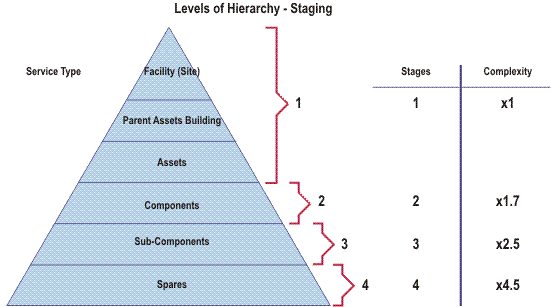Key Cost Elements
The degree of data required to complete asset management is a complex issue impacted on by:
- The type of asset
- The age and condition of the asset
- The criticality of the asset
- The key business drivers or objectives of the organization
- The benefits that will be derived from having this data need to exceed the costs of collecting it and maintaining it.
There is an relationship between the benefits that will be derived and the costs of collecting this data:

In general terms more detailed data can be justified for assets that are:
- Older assets and those that are in poor condition and have a high probability of failure
- Assets whose historical performance has shown them to be unreliable
- Assets whose failure has a high consequence to the organization
- Assets that have a high cost and benefits could be derived through optimized renewal investments.
The key cost elements for data capture involve the following:
Asset Identification
The level in the asset hierarchy that represents an individual maintenance managed item (MMI).
Level of Attributes
The detail of physical data collected on the asset, its condition and performance varies with the sophistication of the asset management being undertaken.
Accuracy
The accuracy or validity of the data collected will impact on the cost of data capture.
Method of Data Capture
The method of data capture and recording will impact on the cost of data capture.
Asset Identification
The level at which we determine the individual maintenance managed items is the main driver in the cost of data capture.
The lower this level is set in the hierarchy of assets will have considerable effect on the data capture cost:

In some cases the individual assets that make up the hierarchical structure will consist of radically different components and each of these may warrant a different level of maintenance-managed item to suit the benefit that will be derived from having this data.
For example, from a life cycle and maintenance management perspective, it is important to hold more detail on mechanical plant in a multi-storey building than it is to hold architectural details. This is because the high maintenance cost and criticality of the services, e.g. the air conditioning system, is of greater importance and therefore of greater benefit than some of the architectural components which have a long life with little maintenance requirement.
It is of course important that we hold sufficient data on the entire facility or building so that we can derive the necessary outputs to appropriately manage and cost this facility. However it is maintenance, operations and the criticality of the components that will determine the degree of data that needs to be captured.
Level of Detailed Attributes
The number of attributes that we wish to collect against each of the hierarchical levels and in particular against the maintenance management item will significantly impact on the cost of data capture.
The organization should:
- Determine the attributes for each hierarchical level down to the maintenance managed item or component
- Record these so that staff and data collectors can easily recognize the attributes required.
Please click here for an interactive sample spreadsheet to save to your computer.
This factor can be offset by the fact that it is sometimes not necessary to collect all attributes all at once.
In many cases the attributes can be broken into different levels of priority to suit the different life cycle functions or outputs that will be required for the individual assets or the system as a whole. The level of attributes will depend on the asset condition and performance output and the sophistication of the processes.
Accuracy of Data
A major factor in the cost of data collection is the level of accuracy or validity that we require for the different attributes or data information.
In some cases accuracy may be critical to the way in which we operate, maintain or manage the asset, whereas in other instances an appropriate estimate may be completely adequate.
The level of accuracy will impact on the benefit cost. Where high levels of accuracy are warranted, they should be adopted.
Many projects in asset management have been significantly delayed and have incurred far greater investments to derive the levels of accuracy where the benefits have proven to be dubious. This is particularly true of asset location in a GIS system, which need to be developed to very high levels of accuracy, resulting in high costs and inordinate delays.
The organization should clearly understand the cost and time implications.
If an organization can only make certain decisions or provide certain advice on the data they have in hand, it is difficult to justify why this level of accuracy should not be initially adopted. Higher levels of accuracy and validity of data can be achieved by ensuring that:
- All faults found with data are quickly rectified and that all staff are encouraged to bring forward problems and to continually enhance the organization’s available data
- All new work or asset creation is recorded to a standard of accuracy appropriate to the cost required to collect it. In these cases it is obvious that higher degrees of accuracy can often be achieved for little additional effort.
The final element involved in the cost of data capture is the efficiency and the effectiveness of the method used to capture the data.